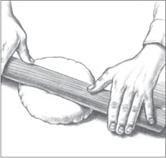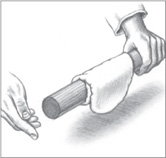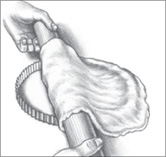French Classics Made Easy (15 page)
Read French Classics Made Easy Online
Authors: Richard Grausman

Shrimp, crab, lobster, or scallops with a curry-flavored béchamel.
Fill with the four-cheese mixture from Four-Cheese Ravioli (
page 84
) and serve with a tomato sauce sprinkled with grated Parmesan.
Butter, for serving dish
16 Savory Crêpes (
page 59
)
¼ pound ham (boiled, baked, or smoked), finely chopped
5 sprigs parsley, chopped
Duxelles (
page 187
)
Mornay Sauce (
page 314
)
1 or 2 tablespoons milk
1 ounce Swiss-style cheese, such as Gruyère or Emmentaler, grated (about ⅓ cup)
1.
Preheat the broiler.
2.
Butter 8 individual oval gratin dishes or 1 large baking dish. Place a stack of crêpes, light side facing up, on a plate.
3.
Stir the chopped ham and parsley into the duxelles. In a saucepan, bring the mornay sauce to a simmer. Add enough sauce to the ham and parsley to bind it, about ¼ cup. Taste and adjust the seasoning if necessary.
4.
Place about 3 tablespoons of filling down the center of the first crêpe. Lift up one edge of the crêpe to cover the filling. Do the same with the other edge, totally enclosing the filling. Place your palms over the crêpe, and with your fingertips facing each other, roll the crêpe onto your hands and transfer it to the baking
dish. The fold of the crêpe should be on the bottom. Repeat with the remaining crêpes. If you are using the individual gratin dishes, place 2 crêpes in each.
5.
Reheat the remaining sauce. Thin with the milk and bring to a boil, whisking well. Spoon the sauce over the crêpes to completely cover. Sprinkle the grated cheese over all the crêpes. (The crêpes can be prepared in advance up to this point. Cover and refrigerate for up to 1 day or wrap tightly and freeze for up to 1 week.)
6.
Place the crêpes under the broiler until the sauce browns lightly, about 5 minutes. Warn your guests that the dishes are
très chaud
(very hot) and serve. (If the crêpes have been made ahead and refrigerated or frozen, bring them back to room temperature before broiling. If time is an issue, you can bake the crêpes straight from the refrigerator or freezer. Reheat them in the upper third of a 475°F oven until the sauce is bubbling and the surface has browned lightly, 10 to 15 minutes. Add a few extra minutes if the crêpes were frozen.)
S
OUFFLE
-F
ILLED
C
REPES
:
Crêpes Soufflés
You can also stuff a crêpe with soufflé batter and then bake it to cook and puff the soufflé. Use any of the first-course soufflés in the book (pages 40–46), and follow the instructions for the dessert version of this soufflé-filled crêpe in “Dessert Crêpe Variations,”
page 280
.
QUICHES
Originally a quiche was a rich cheese custard tart from Alsace and Lorraine. Sometimes it would be made with the addition of ham or bacon.
In France, if you order quiche, you will probably be served a classic quiche Lorraine. A more contemporary and eclectic approach to cooking, however, has made this simple classic a blueprint that can be used with a multitude of added ingredients. Perhaps the most surprising and delicious quiche I’ve tasted in this country was made with jalapeño peppers and Monterey Jack cheese. Another of my favorites is one made with crab and a curry-flavored custard in a puff pastry shell (see Curried Crab Quiche,
page 67
).
The classic custard used for a quiche combines eggs and heavy cream to make a very rich filling. I prefer a lighter custard, using milk instead of cream and fewer eggs to bind it. By using a shallow tart pan with a removable bottom instead of a deep quiche mold or pie dish, the resulting crust will not be soggy and the thinner portions will be more suitable for a first course.
If you’d like to come up with your own combinations of ingredients for a quiche, just keep in mind that you’ll need enough diced ingredients to cover the bottom of the tart shell (about 2 cups).
QUICHE LORRAINE
Quiche Lorraine is the best known of all quiches. It is traditionally made in a deep crust, and one slice can serve as a light meal. I prefer it made with a light and delicate custard in a shallower tart shell and served as a first course. Recipes for this classic quiche vary in a number of ways. Half an onion can be chopped, sautéed, and added to the filling; crumbled bacon can be used instead of ham; and the custard can be made with more eggs and heavy cream.
SERVES 6 TO 8
Tart Pastry (
page 213
)
1 tablespoon Dijon mustard
2 eggs plus
1 egg yolk
1½ cups milk
¼ teaspoon salt
⅛ teaspoon freshly ground pepper Pinch of freshly grated nutmeg
¼ pound ham (boiled, baked, or smoked), diced, or 8 strips of cooked bacon, crumbled
¼ pound Swiss-style cheese, such as Gruyère or Emmentaler, diced, sliced, or grated (about 1⅓ cups)
1.
Preheat the oven to 475°F with the rack set in the middle position.
2.
Line a 9½- or 10-inch tart pan with removable bottom with the pastry (see “How to Line a Tart Pan,” facing page).
3.
Prick the pastry (see Note), line it with aluminum foil, and weight it with 1 pound of dried beans, rice, or aluminum pie weights. Bake until the edges of the pastry begin to color, about 20 minutes. Remove the pan from the oven and remove the foil and beans from the pan. Spread the mustard over the bottom of the pastry. Lower the oven temperature to 425°F.
4.
In a bowl, beat the eggs and yolk lightly. Blend in the milk, salt, pepper, and nutmeg.
5.
Spread the ham and cheese evenly over the bottom of the tart shell. Pour the custard into the tart shell to within ⅛ inch of the top of the crust. Holding the tart pan by the outer rim (so as not to dislodge the bottom), place the pan in the oven.
6.
Bake until the custard puff s, 25 to 30 minutes.
7.
Unmold as soon as possible (see “Unmolding a Tart or Quiche,”
page 218
). Allow to cool for at least 10 minutes before cutting into wedges and serving. The quiche is delicious served at any temperature. (The quiche can be made in advance. It will keep well in the refrigerator for several days. Reheat in a 350°F oven for 10 to 15 minutes before serving.)
NOTE
To help prevent the pastry from bubbling up during baking, prick the bottom all over with the sharp point of a paring knife. Do not use a fork for this purpose, for the holes created may be too large and allow liquids to leak out. (At this point the pastry can be covered with plastic wrap and refrigerated or frozen along with any unused pastry.)
H
OW TO
L
INE A
T
ART
P
AN
1.
Lightly butter your tart pan. You need only a very small amount of butter for this purpose, just enough to hold the pastry in the pan.
2.
Dust the pastry and work the surface lightly. Roll out the pastry (keeping it round), lifting and rotating it one quarter turn after each roll. Dust between each roll. Continue rolling in this fashion until the pastry is about ¼ inch thick.
3.
Roll the pastry onto the rolling pin, turn it 90 degrees, and unroll it onto your lightly floured work surface. Continue this rolling, lifting, and turning process until the pastry is about ⅛ inch thick. Your pastry should be about 14 inches in diameter. Although, by habit I use this method to roll out tart pastry, I sometimes roll it out between two pieces of plastic wrap. This leaves less flour to clean up.
4.
Roll the pastry onto the pin, and unroll it into the tart pan. The pastry will overlap the pan an inch or more.


